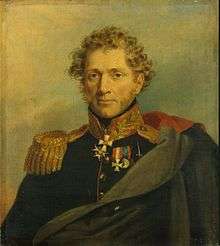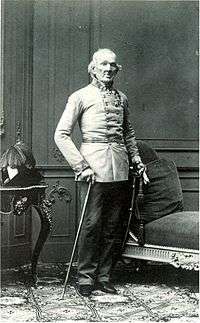Ludwig von Wallmoden-Gimborn
| Ludwig von Wallmoden-Gimborn | |
|---|---|
 Portrait by George Dawe, 1823/25 | |
| Born |
6 February 1769 Vienna |
| Died |
22 March 1862 Vienna |
| Allegiance | Hanover, Prussia, Austria, Russia |
| Service/branch | Light infantry |
| Years of service | Bef. 1790 - 1848 |
| Rank | Befehlshaber |
| Battles/wars |
Napoleonic Wars (Wagram, Russia, Göhrde), Neapolitan War |
Ludwig Georg Thedel, Graf von Wallmoden (6 February 1769 in Vienna – 22 March 1862 in Vienna) was an Austrian "General of the Cavalry", best known for his training of light infantry and the refinement of the Tirailleur system.
Life

Wallmoden was the son of Johann Ludwig Reichsgraf von Wallmoden-Gimborn (1736–1811), an illegitimate son of George II. At the time of Ludwig's birth, Johann was British ambassador in Austria.
Wallmoden first entered the Hanoverian army, and then in 1790 the Prussian Army. While serving in the Prussian army as a captain in Wolfradt's hussars he distinguished himself at the battle of Kaiserslautern winning the Pour le Mérite (Blue Max) but was simultaneously bayoneted in the chest.[1]
After the Peace of Basel (5 April 1795) Wallmoden joined the Austrian army as second captain in Vecsey's Hussars.on 1 January 1797 he was promoted to first captain and joined Karaczay-Chevaulegers. On the 16 April that year he was promoted to Major and joined the quartermaster service. On 7 June 1798 he was transferred to the Dragoon Regiment No. 2. On 3 August of the same year he was promoted to Lieutenant Colonel in Ulanenregimente No. 1 an to Colonel of the same regiment on 16 August 1800.[1]
In 1809 Wallmoden completed the negotiations in London as to the "Subsidienvertrag" between Austria and Great Britain. On his return to Vienna, he distinguished himself a Brigadier-General at the Battle of Wagram. On 6 July, the second day of battle, Wallmoden was responsible for the left flank of the III Corps. He ordered an attack by the Liechtenstein Hussars who on the enemy's right flank, which succeeded in disrupting the enemy and in the capture of nine guns. During the withdrawal of the Austrian army to Moravia, the VI Corps formed the rearguard. Wallmoden led the Liechtenstein and Blankenstein Hussars in a successful delaying action at Hollabrunn (9 July) and on several other occasions. During these regard actions he was lightly wounded and for his achievements at Wagram and in the latter actions he was awarded the Knight's Cross of the Order of Maria Theresia and army Command from 13 July 1809.[1]
After the Treaty of Vienna, Wallmode was promoted to Feldmarschallleutnant on 21 August 1809 and lived in Prague. In 1812 he was given permission by the Austrian Emperor to transfer first to the British Army, and then at the bequest of the British to the Imperial Russian Army, becoming overall commander of the Russian light troops under the commanders Dörnberg and Tettenborn and Chernichev,[1] which became known as the Russian-German Legion, which he merged into the Allied "army of the north". During the Battle of the Göhrde, he and his corps held out against not only General Davout's force but also the French division under Pécheux, later penetrating into Schleswig and forcing the Danes to make peace.. The corps was disbanded upon the fall of Paris in 1814 and on 24 May 1815, Wallmoden rejoined the Austrian army, just in time for the Hundred Days in which he led a column of the Austrian III Corps (Württemberg's) which fought the action at Seltz against the French General Rottembourg, after which his column combined with the other column of the III Corps and fought the Battle of La Suffel before besieging General Jean Rapp in Strasbourg.[2]
In August 1816 he was made Oberbefehlshaber (supreme commander) of the Austrian troops sent to the kingdom of Naples for the Neapolitan War. In 1821 he left the majority of the Austrian force in Naples and in June occupied Sicily, where he remained until 1823.
When in 1827 Naples was completely evacuated by the Austrian troops, Wallmode became on 21 March 1827 Militärcommandant to Milan and he was made a secret counsel on 20 January 1831. On 18 September 1838, he was promoted to General of the Cavalry. On 1 March 1848, he was appointed deputy to Field Marshal Count Radetzky and on 19 October 1848 he was awarder the Grand Cross of the Austrian Order of Leopold in retirement. After his retirement he lived in Vienna and, after falling and breaking his leg, he died there in his 94th year on 20 March 1862, leaving no descendants.[1]
See also
Notes
- 1 2 3 4 5 Pallua-Gall 1896.
- ↑ Siborne 1848, pp. 771–772.
References
- Siborne, William (1848). The Waterloo Campaign, 1815 (4th ed.). Westminster: A. Constable.
 This article incorporates text from a work in the public domain: Pallua-Gall, Julian (1896), "Wallmoden-Gimborn, Ludwig Georg Thedel Graf von", Allgemeine Deutsche Biographie (ADB) (in German), 40, Leipzig: Duncker & Humblot, pp. 761–762
This article incorporates text from a work in the public domain: Pallua-Gall, Julian (1896), "Wallmoden-Gimborn, Ludwig Georg Thedel Graf von", Allgemeine Deutsche Biographie (ADB) (in German), 40, Leipzig: Duncker & Humblot, pp. 761–762
Further reading
| Wikimedia Commons has media related to Ludwig von Wallmoden-Gimborn. |
- "Ludwig Graf von Wallmoden-Gimborn". www.austro-hungarian-army.co.uk. External link in
|publisher=(help)